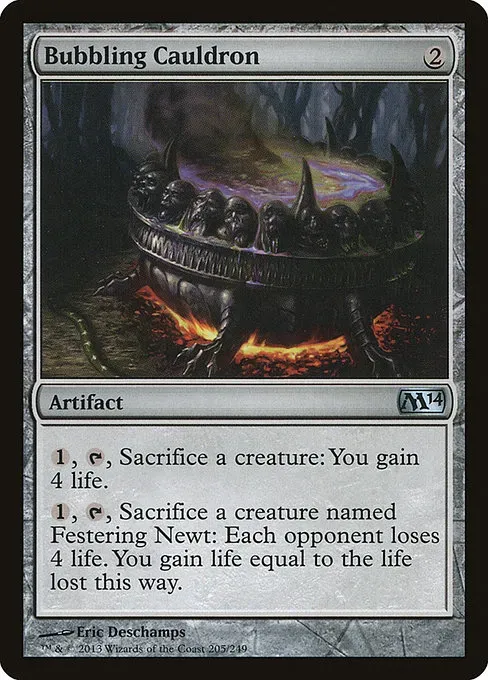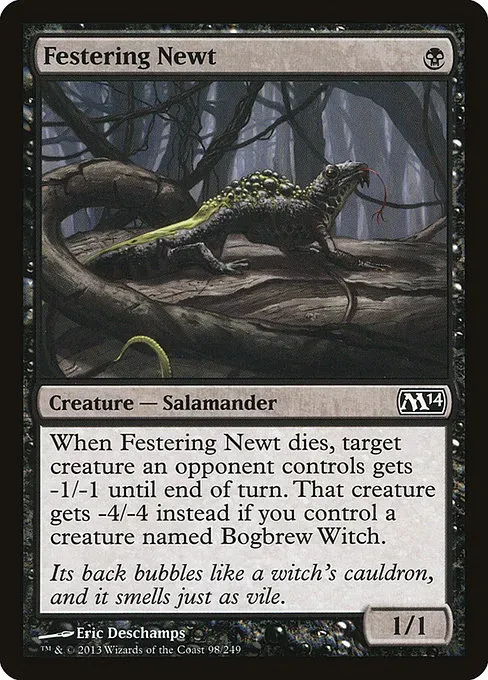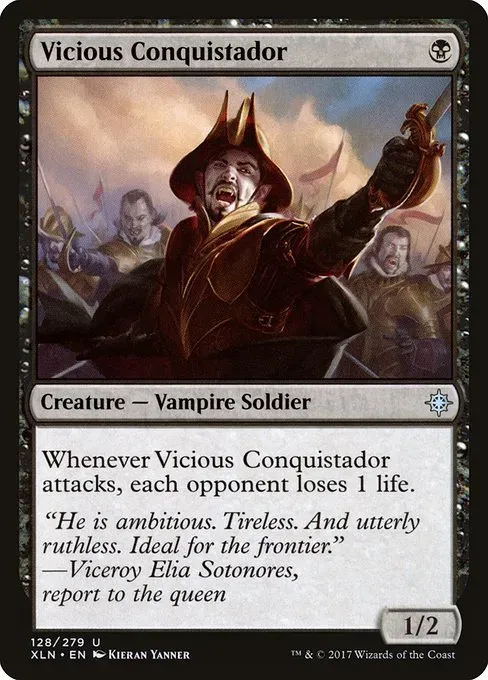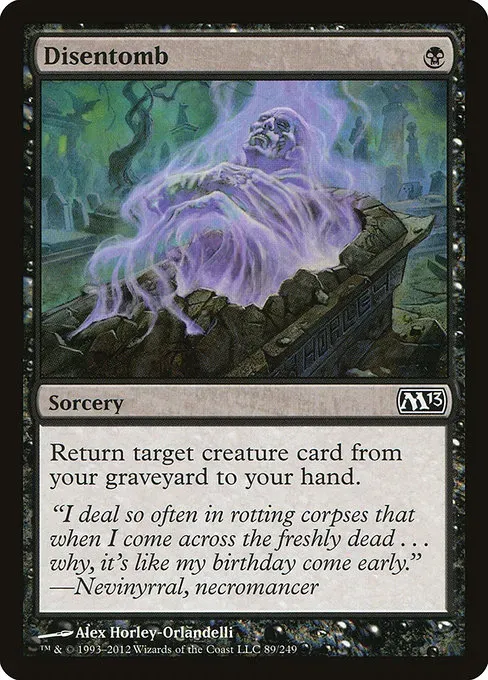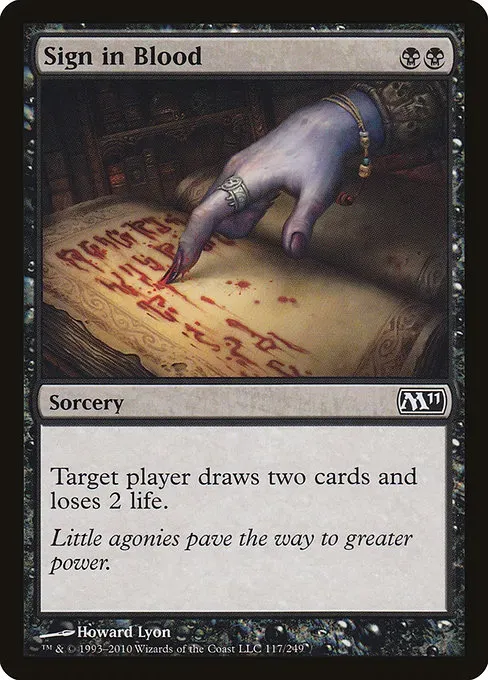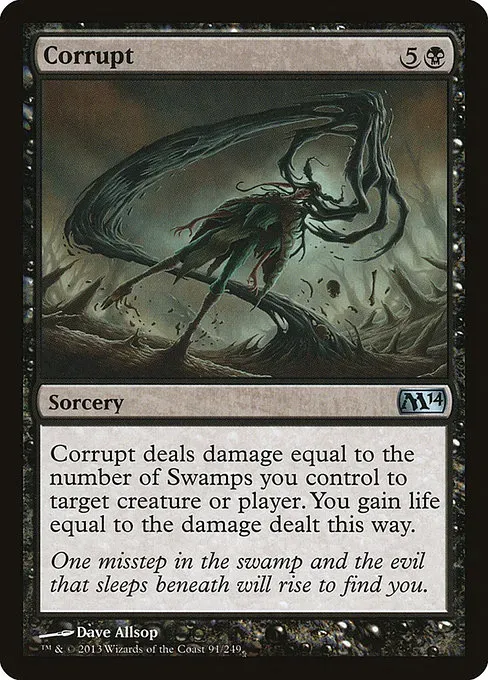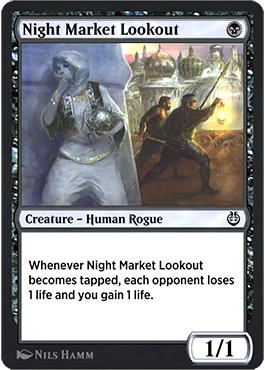OK, maybe, just maybe, there are a few things in tabletop games which look truly evil on the surface. Dungeons & Dragons has demons and polytheistic mythology and warlocks who literally make pacts with supernatural powers while vampires and necromancers stalk forgotten halls or lurk in dark alleys. Card games feature monsters, curses, and sorcery. No wonder puritanical killjoys spin it all out of proportion and level charges of witchcraft and satanism against those of us who enjoy such hobbies. It's utter nonsense, but this deck doesn't really help my case.
Once again, we're revisiting a deck I mentioned before, way back at the end of 2016 on the beta version of HIVE. In fact, I revisited it in 2021 already. But this time, there have been substantial changes on the periphery. Check out the new version, including a proper sideboard, on Moxfield!
The Main Deck

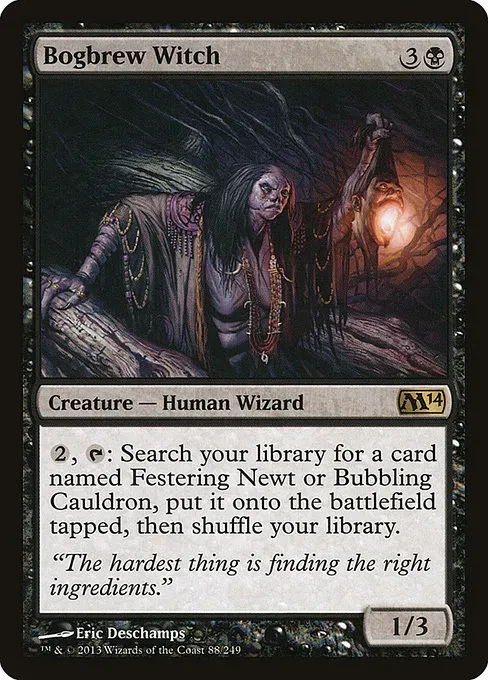

The core combo of Bogbrew Witch, Festering Newt, and Bubbling Cauldron still form the main strategy driving this deck. The witch can tutor up the cauldron and newt. When the newt dies, it weakens an opponent's creature, and with the witch, it weakens them more. The cauldron offers a sacrifice outlet for the newts, life gain, and damage to opponents. It's a potent, but not over-powered, combo. It isn't enough to win the game, though. There need to be other ways to deal damage. That's where the rest of the deck comes into play.
I replaced the Pulse Tracker set with the newer Vicious Conquistador. It has the same effect of pinging an opponent just by attacking, but it has 2 toughness. This good value is reflected in its uncommon rarity.
I still have the pair of Fate Unraveler enchantment creatures. This card has a tidy price of about $4 due to the desirable passive effect of pinging opponents every time they draw and being printed only in one core set and one Commander set as a rare card.
I still have two copies of Geth's Verdict, despite my earlier claims to reconsider it. For one thing, the card is priced higher than most common-rarity cards. For another, the advantage of building a deck with a sideboard means I can still easily try different cards to replace it. More on that later. For now, just remember that forcing an opponent to sacrifice a creature and pinging them for one damage may be better value than I thought initially.
Continuing the necromancy theme, Disentomb lets me retrieve cards from my graveyard and put them in my hand. I can recycle newts, retrieve a witch someone thought was gone, or bring back a Fate Unraveler.
Nothing says "witchcraft" like a curse, so of course I still use a set of Sinister Possession enchantments. Attach it to an opponent's creature so your opponent suffers damage if they use that creature to attack or block. Cruel choices are a hag's business, after all! I initially used Stab Wound for an arguably better version of this effect, but it also had a higher mana cost.
Mana ramp is useful in any deck, and while black doesn't generally have a lot, artifacts can fill the gap, especially if they can also ping an opponent when played. Hierophant's Chalice is on brand. As a mana rock, it's as generic as they come, but pinging an opponent while gaining a life point is great. With all my lands producing black mana, colorless mana from the rock is also A-OK.
Sign in Blood might belong in the main deck. This card is incredibly useful. If I need cards, I can pay life and draw. If my opponent is low on life, they get to draw and die. If Fate Unraveler is on the table, this card hits an opponent for 2 damage, and then the hag triggers on the draw for 2 more damage. Little agonies pave the way to greater power, indeed. This card has been reprinted a lot, but it still commands a high price for a common card due to its utility and synergy. I have 4.
Rounding out the deck is a mana base of 20 Swamps and a set of Piranha Marsh which ping an opponent in exchange for entering tapped. I am considering adding a set of four Barren Moor cycling lands instead of, or in addition to, these. I don't like lands that enter tapped, but the option for late game card draw might be useful. Let me know what you think.
The Sideboard

So why am I writing about a deck mostly unchanged from previous posts? How is this not just content recycling? Simple. There are two main components to a Modern deck:
- A main deck with a minimum of 60 cards and a maximum of 4 copies of any card other than basic lands; and
- A Sideboard of up to 15 additional cards.
Sideboard rules have changed slightly. Once upon a time, the rules said sideboards must include exactly 15 cards, and cards in the sideboard and deck must be swapped one-for-one so the deck size and sideboard size always remained the same. Now, the rules say a sideboard can include up to 15 cards, and do not need to be swapped one-for-one.
In a tournament setting, after the first match in a best-of-three round, players can swap cards between their deck and sideboard to better address an opponent's deck. Any card allowing other cards to be brought into the game from "outside the game" should also be kept in the sideboard.
For my purposes as a casual player, a sideboard also means I can playtest variations on my main deck theme without the tedious process of rebuilding the entire deck for a future event. That's also why I included a sideboard in my recent green infect deck.
Corrupt is a possible game finisher, and at CMC 6, I only want a pair at most in my deck. Again, we have some great flavor text on the card: One misstep in the swamp and the evil that sleeps beneath will rise to find you.
Font of Return is a strange two-stage enchantment I may try if I don't have enough graveyard recursion, or want to change up how it works. This costs CMC 2 to cast, but it has an activated ability costing 4 mana to sacrifice the enchantment and return up to three creature cards from my graveyard to my hand. If I face board wipes, I may need to get a lot back. I only have two in the sideboard though.
I pulled the pair of Isolation Cell cards from my infect deck where they didn't make any sense and put them here as possible answers to creature-heavy aggro decks. Again, hags like offering no-win choices. Want to cast a creature? Take 2 damage, or pay an extra tax of 2 mana, it's up to you...
Night Market Lookout is another possible alternative to Pulse Tracker. It doesn't have the toughness bonus of Vicious Conquistador, but if I can find ways to tap it for other purposes, it can ping opponents even more effectively. Maybe if I include vehicles? But I think this card may get replaced eventually because it would be a better fit in a different deck entirely. I'm mainly including it here because it was another possible upgrade from the first version, and I haven't decided what to use instead.
Vile Rebirth was in the main deck before. It turns dead creatures into zombies for my army. And not just my dead creatures, but those in my opponent's graveyard as well. It may be a common card, but necromancy is black's domain, and I may want to interfere with an opponent's graveyard strategies. Plus, I still love the flavor text on this card. Grave robbers digging down cautiously listen for anything digging up.
I'm not sure whether Secret Salvage is a good card for this deck, but I may mix it in and see what happens. CMC 5 is a lot, and I have better tutor effects and better uses for cards in my graveyard, but I could be wrong. Getting all the Vile Rebirths or Sinister Possessions could help turn a game.

Conclusion
This deck is still fundamentally the same, but I have ideas to improve it, and a well-stocked sideboard lets me shift the strategy to more creatures or more interaction as needed without ruining what I think is a solid core deck. It's also less than $35 as of this post to buy the whole deck including sideboard as singles, or under $20 if you just swap in Corrupt or Isolation Cell for Fate Unraveler and ditch the rest of the sideboard entirely.
This isn't a tournament winner, but it's great for teaching new players about different card types, basic combos, and interaction with the board. Learning to use life and creatures as resources also makes players see more opportunities for deck construction. Sacrificing creatures and exploiting the graveyard is absolutely thematic for black, too.
What do you think, though? Are there better synergies I should consider for this deck? How would you counter it before its combos and constant death-by-a-thousand-cuts strategies whittle your life total to zero?

